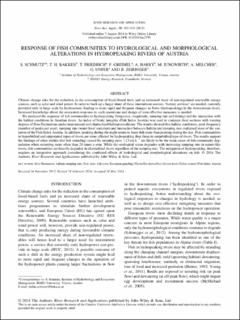| dc.contributor.author | Schmutz, S. | |
| dc.contributor.author | Bakken, Tor Haakon | |
| dc.contributor.author | Friedrich, T. | |
| dc.contributor.author | Greimel, F. | |
| dc.contributor.author | Harby, Atle | |
| dc.contributor.author | Jungwirth, M. | |
| dc.contributor.author | Melcher, A. | |
| dc.contributor.author | Unfer, G. | |
| dc.contributor.author | Zeiringer, B. | |
| dc.date.accessioned | 2020-03-20T14:30:12Z | |
| dc.date.available | 2020-03-20T14:30:12Z | |
| dc.date.created | 2014-08-08T09:30:57Z | |
| dc.date.issued | 2015 | |
| dc.identifier.citation | Rivers Research and Applications: an international journal devoted to river research and management. 2015, 31 (8), 919-930. | en_US |
| dc.identifier.issn | 1535-1459 | |
| dc.identifier.uri | https://hdl.handle.net/11250/2647903 | |
| dc.description.abstract | Climate change asks for the reduction in the consumption of fossil-based fuels and an increased share of non-regulated renewable energy sources, such as solar and wind power. In order to back up a larger share of these intermittent sources, ‘battery services’ are needed, currently provided only in large scale by hydropower, leading to more rapid and frequent changes in flows (hydropeaking) in the downstream rivers. Increased knowledge about the ecosystem response to such operations and design of cost-effective measures is needed. We analysed the response of fish communities to hydropeaking (frequency, magnitude, ramping rate and timing) and the interaction with the habitat conditions in Austrian rivers. An index of biotic integrity (Fish Index Austria) was used to compare river sections with varying degrees of flow fluctuations under near-natural and channelized habitat conditions. The results showed that habitat conditions, peak frequency (number of peaks per year), ramping rate (water level variation) and interaction between habitat and ramping rate explained most of the variation of the Fish Index Austria. In addition, peaking during the night seems to harm fish more than peaking during the day. Fish communities in hyporhithral and epipotamal types of rivers are more affected by hydropeaking than those in metarhithral type of rivers. The results support the findings of other studies that fish stranding caused by ramping rates >15 cm h−1 are likely to be the main cause of fish community degradation when occurring more often than 20 times a year. While the ecological status degrades with increasing ramping rate in nature-like rivers, fish communities are heavily degraded in channelized rivers regardless of the ramping rate. The mitigation of hydropeaking, therefore, requires an integrative approach considering the combined effects of hydrological and morphological alterations on fish. © 2014 The Authors. River Research and Applications published by John Wiley & Sons, Ltd. | en_US |
| dc.language.iso | eng | en_US |
| dc.rights | Navngivelse 4.0 Internasjonal | * |
| dc.rights.uri | http://creativecommons.org/licenses/by/4.0/deed.no | * |
| dc.subject | flow fluctuation | en_US |
| dc.subject | habitat | en_US |
| dc.subject | ramping rate | en_US |
| dc.subject | flow ratio | en_US |
| dc.subject | fish zone | en_US |
| dc.subject | European grayling (Thymallus thymallus) | en_US |
| dc.subject | brown trout (Salmo trutta) | en_US |
| dc.subject | Fish Index Austria | en_US |
| dc.title | Response of Fish Communities to Hydrological and Morphological Alterations in Hydropeaking Rivers of Austria | en_US |
| dc.type | Peer reviewed | en_US |
| dc.type | Journal article | en_US |
| dc.description.version | publishedVersion | en_US |
| dc.rights.holder | The Authors | en_US |
| dc.source.pagenumber | 919-930 | en_US |
| dc.source.volume | 31 | en_US |
| dc.source.journal | Rivers Research and Applications: an international journal devoted to river research and management | en_US |
| dc.source.issue | 8 | en_US |
| dc.identifier.doi | 10.1002/rra.2795 | |
| dc.identifier.cristin | 1145811 | |
| dc.relation.project | Norges forskningsråd: 193818 | en_US |
| cristin.unitcode | 7548,50,0,0 | |
| cristin.unitname | Energisystemer | |
| cristin.ispublished | true | |
| cristin.fulltext | preprint | |
| cristin.qualitycode | 1 | |

